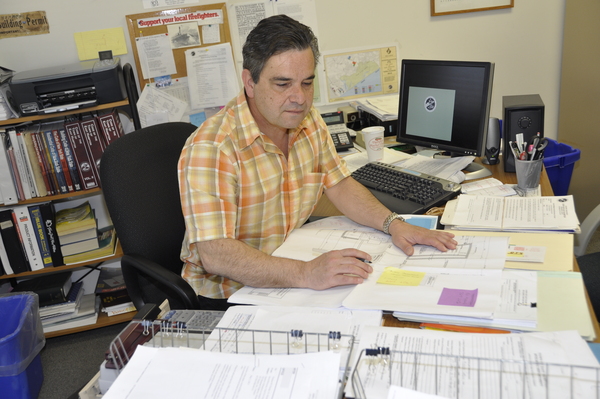
All Ira Rennert had to do was ask.
But instead, the billionaire investor wheeled cement trucks onto his 63-acre estate in Sagaponack on April 18 to start a new project, which caught the attention of Village Building Inspector John Woudsma, who found no building permit on file for the 66,000-square-foot compound. As a result, he issued a stop work order.
“The activity was hard to miss,” Mr. Woudsma said last week at his office. “He fully complied with the stop work order. I had a meeting with the property manager where different options and ideas were discussed, and they’re deciding what avenue to go down.”
While Mr. Woudsma declined to identify what Mr. Rennert plans to build, he quashed rumors that the new structure will house the homeowner’s extensive art collection. It has been widely speculated that Mr. Rennert would erect a museum on his property.
“There’s no museum, there’s no museum,” Mr. Woudsma said. “We haven’t generated a special permit for museums yet. What they’re doing is far from being a museum.”
Mr. Rennert’s estate, reportedly the largest residential compound in the country, includes a 57,770-square-foot mansion, a playhouse, power plant, 20-car garage, beach pavilions and other accessory structures. It was built amid controversy in 1999 and completed in 2003 on a former potato field on Daniels Lane.
The Sagaponack Building Department issues between two and six stop work orders every year, Mr. Woudsma said. In 2010, the department processed 44 building permits.
“A stop work order for this village is a last resort,” Mr. Woudsma said. “It means that all attempts of verbal and written communication for compliance have failed, and we have no other choice than to hand you a stop work order. Just comply. Just come legal. We’re very easy to get along with.”
If the homeowner does not adhere, the case is referred to the village attorney and the court. If the construction still does not cease and desist, the owner can receive fines of up to $1,000 a day for non-compliance, and even jail time.
“Is jail time out of the realm of possibility? No,” Mr. Woudsma said. “There have been full houses built without a permit, basically giving the bird to the building inspector and the Town of Southampton. Those will wind their ways through the courts.”
As of Friday afternoon, Mr. Rennert had not filed a building permit, Mr. Woudsma said. But once he does—and it is complete with all of the fixings, like insurances, surveys and plans—Mr. Rennert will be back on the right track.
“My biggest piece of advice is before you start building, check with your local building department to see if you need a permit,” Mr. Woudsma said. “Most of them are very friendly and would much rather prefer that you ask before you do.”
Town Building Inspectors in Southampton and East Hampton doled out the same advice.
“Get your permits before you start building,” said Michael Benincasa, the chief building inspector in Southampton. “If you put something in the wrong spot, you could be moving it or applying for a variance, and they double or triple the fees for that.
“Dealing with this is routine business for us, but a nightmare for homeowners,” he continued. “It costs them more money, more time. So come in here, we smile when we can,” he laughed, “and we help you through the process.”
Between new residences, additions and renovations, the Southampton Town Building Department issued nearly 750 building permits in 2010, Mr. Benincasa reported. He added that he hands out three to six stop work orders per month, while code enforcement dishes out two or three a day.
Mr. Benincasa said that sometimes building without a permit is an honest mistake but he often finds that homeowners think it is easier to ask for forgiveness than permission first. Routine, as-of-right maintenance does not require a building permit, the inspector said.
In Southampton, the permitting process can cost between $100 and $12,000 and take anywhere from 45 minutes to two weeks, if it’s a straightforward application. In East Hampton, fees range from $50 to $13,000 and permit approval can take two weeks to a year, if additional boards need to sign off on the plans.
Many a time, homeowners dodge the building application to skirt fees and a lengthy approval process, which East Hampton Senior Building Inspector Tom Preiato said is sometimes necessary.
In 2010, the East Hampton building department issued 884 building permits, Mr. Preiato reported. He said that the department issues one or two stop work orders per month.
“I try to seek voluntary compliance first,” Mr. Preiato said. “If I wanted to be a cop, I’d be a cop. The bottom line is safety. It’s all in their best interest. We’re doing it for the homeowner. We want to help you get a solution, we’re not looking to clog up the court.”